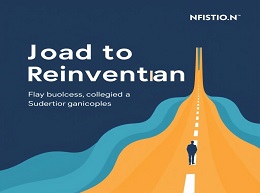The Road to Reinvention: How to Drive Disruption and Accelerate Transformation

The Road to Reinvention: Mastering Disruption and Transformation
In today's fast-paced and ever-evolving business landscape, companies and individuals must continuously reinvent themselves to stay relevant and competitive. "The Road to Reinvention: How to Drive Disruption and Accelerate Transformation" by Josh Linkner offers a comprehensive guide to navigating this challenging terrain. This review explores the book's key themes, strategies, and practical insights, supported by real-world examples to demonstrate how these concepts can be effectively applied.
Embracing Change
Linkner begins by emphasizing the necessity of embracing change. In a world where technological advancements and market dynamics shift rapidly, those who resist change are left behind. Reinvention is not just a one-time effort but a continuous process that requires a proactive approach.
Example: Kodak’s Decline
Kodak’s failure to embrace digital photography is a classic example. Despite inventing the first digital camera, Kodak clung to its film business, ultimately leading to its downfall. This illustrates the importance of adapting to new technologies and market demands.
The Innovation Mindset
Central to reinvention is cultivating an innovation mindset. Linkner argues that innovation should be embedded in the organizational culture, encouraging experimentation and risk-taking. This mindset enables companies to anticipate disruptions and respond effectively.
Practical Insight: Google’s 20% Time
Google’s famous "20% time" policy, which allows employees to spend 20% of their time on projects of their choosing, fosters a culture of innovation. This policy has led to the creation of successful products like Gmail and Google News, demonstrating the power of encouraging creativity and experimentation.
Identifying Opportunities
To drive disruption, it is crucial to identify opportunities that others overlook. This involves staying attuned to industry trends, emerging technologies, and customer needs. Linkner provides frameworks for spotting these opportunities and capitalizing on them.
Example: Netflix’s Shift to Streaming
Netflix’s transition from DVD rentals to streaming is a prime example of identifying and capitalizing on an emerging opportunity. Recognizing the potential of digital streaming early on, Netflix disrupted the traditional rental market and established itself as a leader in the industry.
Leveraging Technology
Technology is a key driver of disruption. Companies must harness technological advancements to create innovative solutions and improve efficiencies. Linkner highlights the importance of investing in technology and staying ahead of tech trends.
Practical Insight: Tesla’s Autonomous Driving
Tesla’s investment in autonomous driving technology exemplifies leveraging technology for disruption. By pioneering self-driving capabilities, Tesla not only differentiates itself from other automakers but also positions itself at the forefront of the automotive industry’s future.
Building Agile Teams
Agility is essential for responding to disruptions and driving transformation. Linkner advocates for building agile teams that can quickly adapt to changes and pivot when necessary. This involves fostering a flexible work environment and empowering employees to make decisions.
Example: Spotify’s Squads
Spotify’s organizational structure, which consists of small, cross-functional teams known as squads, promotes agility and innovation. These squads operate autonomously, allowing Spotify to rapidly develop and deploy new features in response to market changes.
Creating a Vision for Change
A clear vision is fundamental to any transformation effort. Linkner stresses the importance of articulating a compelling vision that inspires and aligns the organization. This vision serves as a guiding light, ensuring that all efforts are directed towards a common goal.
Practical Insight: Microsoft’s Transformation under Satya Nadella
Under CEO Satya Nadella, Microsoft embraced a new vision centered on cloud computing and artificial intelligence. This vision transformed the company’s culture and business model, leading to a resurgence in innovation and market leadership.
Engaging Stakeholders
Successful transformation requires the support and engagement of all stakeholders, including employees, customers, and investors. Linkner outlines strategies for effectively communicating the vision and involving stakeholders in the transformation process.
Example: Starbucks’ Customer-Centric Approach
Starbucks’ transformation under Howard Schultz involved engaging customers and employees in the company’s new vision. By focusing on customer experience and employee satisfaction, Starbucks revitalized its brand and achieved sustained growth.
Measuring Progress
To accelerate transformation, it is essential to measure progress and adjust strategies accordingly. Linkner recommends establishing key performance indicators (KPIs) and using data-driven insights to guide decision-making.
Practical Insight: GE’s Digital Transformation
GE’s digital transformation involved implementing KPIs to track progress and ensure alignment with strategic goals. By continuously measuring and refining their approach, GE was able to drive significant improvements in efficiency and innovation.
Managing Resistance
Resistance to change is a common challenge in transformation efforts. Linkner provides strategies for managing resistance, including transparent communication, involving employees in the process, and addressing concerns proactively.
Example: IBM’s Cultural Shift
IBM’s shift from hardware to software and services faced internal resistance. By involving employees in the change process and providing clear communication and support, IBM successfully navigated this resistance and achieved its transformation goals.
Balancing Short-Term and Long-Term Goals
Balancing short-term performance with long-term transformation goals can be challenging. Linkner advises maintaining a focus on the long-term vision while ensuring that short-term actions align with this vision.
Practical Insight: Amazon’s Long-Term Focus
Amazon’s emphasis on long-term growth over short-term profits has been a key factor in its success. By prioritizing customer satisfaction and market expansion, Amazon has built a resilient business model that drives sustained growth.
Disrupting Traditional Industries
"The Road to Reinvention" provides numerous case studies of companies that have successfully disrupted traditional industries. These examples offer valuable lessons on how to identify opportunities, leverage technology, and build agile teams.
Example: Uber’s Disruption of Transportation
Uber’s disruption of the traditional taxi industry demonstrates the power of leveraging technology and innovative business models. By providing a more convenient and efficient service, Uber transformed the transportation landscape globally.
Continuous Improvement and Adaptation
Reinvention is an ongoing process that requires continuous improvement and adaptation. Linkner emphasizes the importance of staying agile and responsive to changing market conditions and technological advancements.
Practical Insight: Apple’s Product Evolution
Apple’s continuous evolution of its product line, from the iPod to the iPhone and beyond, showcases the importance of continuous improvement. By consistently innovating and adapting to market trends, Apple maintains its position as a market leader.
Embracing the Road to Reinvention
"The Road to Reinvention: How to Drive Disruption and Accelerate Transformation" offers a comprehensive guide to navigating the challenges of a rapidly changing business environment. By embracing change, fostering an innovation mindset, and implementing the strategies outlined in the book, companies and individuals can drive disruption and achieve sustained success.













